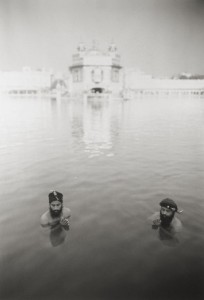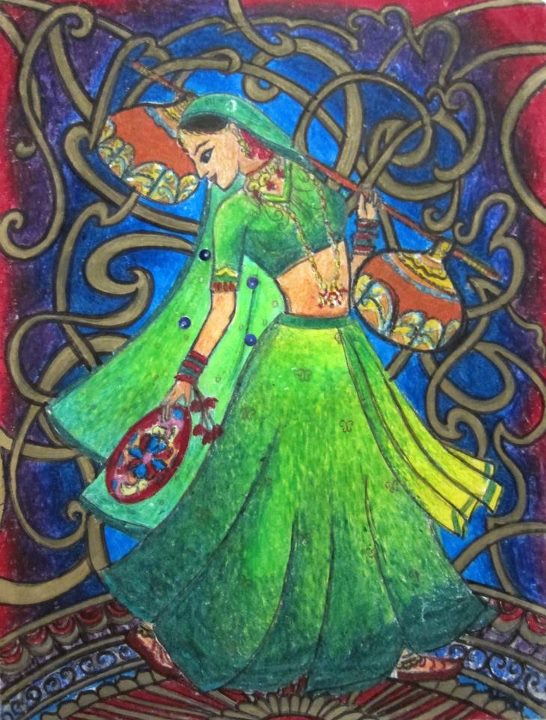
Guest blogged by Harleen Kaur

 Sangat: a concept that has been emphasized to me, and thus I have reiterated to others, for as long as I can remember. My mom telling me to be aware of the friends I was keeping at school, my camp counselors telling me that I should strive for sadh sangat, or people who will push me to be better in every moment.
Sangat: a concept that has been emphasized to me, and thus I have reiterated to others, for as long as I can remember. My mom telling me to be aware of the friends I was keeping at school, my camp counselors telling me that I should strive for sadh sangat, or people who will push me to be better in every moment.
As a young Sikh girl growing up in Wisconsin, sangat was something that was redefined for me every day. Although I found it in my peers on my softball team to my friends in the school musical, the sangat I truly desired was the one I found at gurdwara and at the local Sikh youth camp. With such a small Sikh community in Wisconsin, however, it was not something that was easily found. Sangat came in moments few and far between, and it was often something that I desired more than what I received.
Guest blogged by Moninder Singh
I am for Palestinian statehood, and at the same time I am for the existence of the state of Israel. I am against rockets fired into civilian areas killing innocents indiscriminately, but I am even more against what can only be seen as purposely targeted air strikes against the children and innocents of Gaza. I am against those who think the existence of Jews and Israel must be challenged, and in the same breath, I am against Zionist and Israeli nationalism that doesn’t recognize the state of Palestine or the right to self-determination of the Palestinian people. It is indeed that simple in my mind.

A recent Palestine solidarity rally in the Bay area. Photo by Gurinder Singh Wadhwa.
It was only a recent photograph of a forward thinking and young Sikh waving a Khalistan flag at a pro-Palestine rally in California  that pushed me to give my views on the topic as well– but as a Sikh and not a wannabe political analyst. For weeks I have been listening to conversations from many within the Sikh community on the issue of Palestinian statehood versus the existence of Israel. The underlying question nobody is really touching on is, why does it have to be one or the other?
This illegal occupation and massacre instigated and carried out by Israel with excuses of Palestinian aggression has nothing to do with the fact that Yasser Arafat (former Leader of the Palestine Liberation Organization) was close to Indira Gandhi or the fact that Israel was instrumental in training Indian law enforcement agencies on dealing with threats to their national security which were also deployed in Punjab against Sikhs throughout the 1990s. These actions do not define the masses or their rights. It defines only misguided leadership and corrupt governments. What is even more troubling is the refusal of many Sikhs to comment on this issue by stating, “I am not an expert in Palestinian/Israeli affairs.” But who said you had to be? If it is only the “experts†that are needed to make decisions on the fate of an entire population, then we as Sikhs should take up shovels for digging graves and hauling carts of wood for funeral pyres because the oppressed peoples of the world who are resisting tyranny like the Palestinians will need them today, and make no mistake that we ourselves will likely need them tomorrow…just like we did yesterday.
A revolution never did and never will need “experts.†A revolution needs nothing but the people. And from them it demands their minds for the ability to think without fear, it demands their voices for the ability to speak without fear, and if needed, it will demand their blood to accomplish their dream to live without fear. It should never be that the oppressed of yesterday becomes the oppressor of today, but when that does happen and as it has happened in the case of Israel oppressing our Palestinian brothers and sisters, we as Sikhs have a duty to uphold the principles of our Gurus and stand in solidarity with and struggle alongside those who are being oppressed.
(more…)
An unexpected video posted on the Jezebel.com has gone viral in the last 24 hours. The moving clip highlights the  story of 23-year-old Harnaam Kaur from Slough, UK who has a full beard. Harnaam’s polycystic ovary syndrome led to her facial and body hair growth as a pre-teen, resulting in intense bullying and harassment from her peers. Harmaan took amrit as a 16-year-old, proudly embracing her Sikh identity and her unshorn hair — facial hair included.  It seems the teenage Harnaam found the strength to overcome years of isolation and self-loathing in part through Sikhi.
Guest blogged by Herpreet Kaur Grewal
Editorial note:Â the author talked to her colleagues on the Sikh Feminist Research Institute’s editorial board about why they are feminists. This blog post collects their views to mark the Sikh festival of Vaisakhi, which took place this weekend.
When you hear the words ‘Sikh feminist’ what images does it bring to mind? Perhaps it evokes a general image of Asian women holding placards and angrily protesting? Or maybe it reminds one of a grand warrior saint like Mai Bhago riding her horse into battle? Or possibly a more contemporary incident comes to mind, like the one of Balpreet Kaur who last year deflected taunts from an Internet troll by eloquently explaining why she decides to keep her facial hair in a society where women are largely pressured to be perfectly formed and hairless. Or maybe it evokes none of these images.
As editorial board members of a Sikh feminist body we feel compelled to express our philosophy as a proactive and empowered one. All of us look to the Sikh (and non-Sikh) values of equality, honesty and strength (among many others), to anchor our lives in an everyday spirituality. But that doesn’t mean our motivation has always rooted from a positive place.
One of us was sexually assaulted which absolutely shattered a personal notion that being strong, assertive and smart can keep you insulated from an attack. If anything, it laid bare the vulnerability that exists if you happen to be born a woman in a world that can devalue one so extremely and how that devaluation is integrated into the culture and system we live with. A culture and system which many men and women internalise – sometimes, to a massive extent.
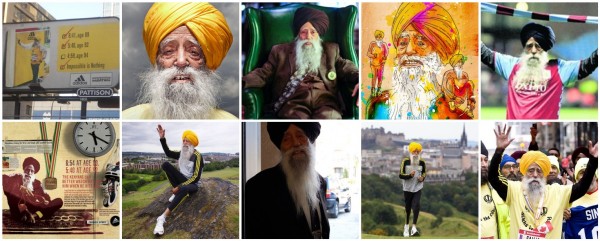
We love Sardar Fauja Singh. Â We really, really do.
On Sunday, Fauja Singh will run his final race in Hong Kong at the tender age of 101.  Jezebel recently covered Fauja Singh in a piece about  women’s rights, and just today Jordan Conn wrote a compendious and inspiring article for Outside The Lines on ESPN about Fauja Singh’s life and the “missing” Guinness Book of World Records title.  This article, along with stunning photographs, spread like wildfire on Facebook and Twitter today – reminding us just how much the world loves Fauja Singh and what he represents.
On the first day of training, Fauja arrived limber and energetic and dressed, as he believed was perfectly appropriate, in a dazzling three-piece suit. Harmander told him he needed a wardrobe change. After adamant protests, Fauja relented, ditched the suit and bought running gear. He showed up every day after that, building his routine around his training schedule. His mileage increased as the weeks passed. Race day arrived. After 6 hours and 54 minutes, 4:48 behind winner Antonio Pinto, Fauja crossed the finish line. At age 89, he was a marathoner. Soon, he would be a star.
We will be wishing you well on Sunday, Fauja Ji! Â Thank you for continuing to be such an activist and a positive soul and for reminding us of the importance of health and happiness.
– The Langar Hall
Guest blogged by Gunita Kaur Singh
Being a nonconformist builds character, but only when it is exercised within a certain framework of values. A prime example of this lifestyle is embodied within the Sikh religion.
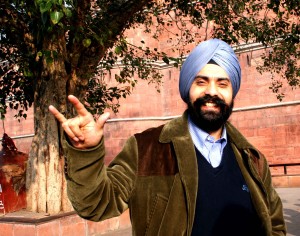
Gunita’s father
Sikhism is very progressive for it allows the practitioner freedom from dogmatism, hence distinguishing it from other religions. However, it is encouraged to use said freedom for the purpose of enhancing a Sikh’s devotion to God and truthful living.
Guru Nanak was a definite nonconformist during his time because he spoke out against the subjugation of women to men, the anthropocentric concept of God, and the prominence of ritualism. The release from these binding ideals gives a Sikh the freedom to live her life as she wishes; even in simply viewing God as the universe itself, a Sikh must still appreciate and value God, but she has the ability to do so in the manner which is most personal and ideal for her mindset. This is the best example to depict nonconformity within a values framework.
Alan Keightley had said, “Once in a while it really hits people that they don’t have to experience the world in the way they have been told to.”
Nanak realized this because a central idea which he would teach seekers of his knowledge was that we belong to nobody, and nobody belongs to us. This notion helps to emancipate individuals from the confinement of bodies, and transcend into spirit form. It also tells us that we never have to be marginalized to institutions or authoritarians.
In a recent piece on BBC Radio 4, titled Beyond Belief – Women in Sikhism, host Ernie Rea starts off with this statement,
“The Sikh religion is the world’s fifth largest… the men are often easily recognized – they wear turbans and leave their hair uncut. Â The fundamental message appears to be simple – God is one and all people are equal. Â But are some more equal than others? Â If the Sikh scriptures are consistent with a feminist agenda, why do some Sikh women feel like they are second class citizens?”
The host is joined by a panel of three women to discuss the issue of equality within the Sikh faith – Navtej Purewal, Lecturer in the School of Social Sciences at Manchester University; Eleanor Nesbitt, Professor Emeritus at the Institute of Education in the University of Warwick; and Nicky Guninder Kaur Singh, Professor in the Department of Religious Studies at Colby College.  The panelists did a great job of explaining what in fact Sikh scriptures say about equality and the role of women.  In addition, they helped identify the gaps that still exist between what is written and how it is practiced.  While these women speak predominately from an academic standpoint and not necessarily the community Sikh women’s voice, i think they brought forth a much important discussion for our community as a whole.  It was also quite eye-opening to hear the non-Sikh perception of our faith, represented by the host.
While parts of the conversation – often guided by host Ernie Rea – landed on discussions around topics that are common to this blog, (i.e. if Sikhi believes in equality, why does Panjab have the highest rates of female foeticide and if Sikhi is an egalitarian faith, why do men and women sit separately within the Gurdwara), the overall discussion was helpful as it raised questions that need to be addressed if changes are going to be made. Â The host began by asking whether or not the Sikh scripture does include a feminist agenda.
Purewal noted that the the Guru Granth Sahib was very revolutionary and, as far as doctrine, it does have the potential to be feminist.  However, due to social convention the message has not been actualized among Sikh communities, whether in India or within the diaspora.  Nesbitt suggested that since the scripture is predominately written in poetry, it is thus open to interpretation and that this is potentially the cause for much of the tensions felt by contemporary women.  Singh goes on to say that even the word “God” brings forth the notion of a male entity which is a starting point for many misconceptions and in fact, in the Guru Granth Sahib Ik Onkaar does speak to being gender-free.
Today’s Lens section of the NYTimes highlights the work of photographer Kenro Izu, whose images of sacred spaces in India will be on display at the Howard Greenberg Gallery in Manhattan.  The article opens with a black and white image of a woman sitting on the parkama facing the Darbar Sahib in Amritsar and is followed by other striking images showing how faith plays out in daily life.
The exhibition, titled “Where Prayer Echoes” focuses not on the structures of these sacred spaces, but rather on the individuals who go to pray at these sites.  This particular exhibition covers the photographer’s trip to India and includes portraits of people who follow various religions, from Hinduism and Islam to Sikhism and Jainism.
For more than 30 years Mr. Izu has been on a pilgrimage of sorts, taking exquisitely classic landscapes and portraits of sacred places and the faithful.
At first, he was interested only in pictures of grand temples, pyramids and holy sites.
But then he had a revelation.
“Before, I was just attracted to form,†Mr. Izu said. “In the last 10 years, I am more interested in the humans who go into these structures. That is where the spirit is. Without the people who pray or offer flowers, it’s just a structure.â€
The exhibition will be on display through February 23rd 2013.
Disclaimer for non-Sikhs: In writing this, I am not in any way saying Sikhs are somehow more predisposed to violence than any other community. The last thing I want to do is perpetuate racist stereotypes about Sikhs. However, I write because I see an opportunity for introspection in our community. If you choose to continue reading, I encourage you to think about how similar dynamics may play out in your community/ies.
I am still having a hard time wrapping my head around what happened in Newtown, CT last week, especially given the kind of year it has been here in the United States, from Aurora, CO to Oak Creek, WI.
For now, I want to pick up the conversation where Nina left off. Indeed, heartbreak is the right word for how I’m feeling about the deaths of children and adults due to gun violence, including those that don’t make the national news headlines, whether they are youth of color shot by police officers or families in Afghanistan bombed by the U.S. military.
Today, the depth and pervasiveness of violence in American culture is more clear than ever. The evening of the tragedy in Newtown, Michael Moore who made the Oscar-winning film about school shootings in 2002, Bowling for Columbine, stated:
I like to say that I sort of agree with the NRA when they say, ‘Guns don’t kill people, people kill people,’ except I would just modify that a bit and say, ‘Guns don’t kill people, Americans kill people,’ because that’s what we do. We invade countries. We send drones in to kill civilians. We’ve got five wars going on right now where our soldiers are killing people–I mean, five that we know of. We are on the short list of illustrious countries who have the death penalty. We believe it’s OK to kill you when you’ve committed a crime.
As a community, we have an incredibly rich history and yet we often know so little about it. The first time I learned about the Sikligar community was after watching Mandeep Sethi’s documentary at a local film festival, about this community of Sikhs known to be the weapon makers of the Khalsa army. Unfortunately, very little is known about the Sikligars by those living both within and outside of India and Mandeep’s film will be a first glimpse into the community for many. The Sikligars are found across India – displaced through years of colonization and government oppression. It is known that the community was given the name Sikligar by the 10th Guru of the Sikhs, Guru Gobind Singh Ji and yet even this honor has not prevented the community from struggling – Sikligars now live in extreme poverty in the slums of Rajasthan, Delhi and Agra. There are also encampments in Punjab. Although this community has been largely illiterate for the last 300 years (focusing on their trade and thus livelihood), the Sikligars are beginning to empower themselves through different means such as education. For the first time, the full length documentary is available online! Over the past few months, I’ve joined Mandeep at several film screenings of his documentary and I’ve asked him some questions about SIKLIGAR which you can find after the jump.
Guest blogged by Nina Chanpreet Kaur
In September, I attended a Sikh awareness training at the Department of Justice in Washington, D.C. Sitting in the audience, I watched and listened as the presenter referred to Sikh women in passing and brought the Sikh male experience and turban to the center of the stage. During the Q&A, a woman behind me stood up. It was evident that she had heard Kaur for the first time during the presentation. She pronounced it “hora” then “whore” until she was finally corrected to “Kaur” as in core. It reminded me of how obsolete Kaur has become. I was also reminded of a dear friend of mine who recently told me about a reunion visit she had with some of our long time, mutual friends. As the usual gossip and updates ensued, someone mentioned my change of last name to Kaur and whispers and glances shot around the room. One woman surmised that I had gotten married. I had at that point received many Facebook messages congratulating me on my marriage. When my friend assured them, despite their insistence, that I had not gotten married another woman speculated that I had just become suddenly religious and so of course I changed my last name.
Across the globe today, our last names generally link us to patriarchy through kinship reference and in many cases ethnic, national, religious and class ties as well. In India and the South Asian diaspora, someone’s last name alone indicates what village or city she is from, her religious affiliation, familial ties, and even her family’s occupation and class status. In 1699 Guru Gobind Singh Ji, the 10th Guru of Sikhism and my spiritual father, asked Sikh men to take on the last name Singh meaning lion and Sikh women to take on the last name Kaur meaning prince. This request was intended to bring equality to a society then entrenched in inequality through caste, classism and sexism. Our world today remains entrenched in inequality.
Guru Gobind Singh Ji’s call for Singh and Kaur was more than a request to fight classism and kinship preference, it was a demand to subvert the structure of patriarchy and class structure as we know it. It was a call for revolution, the type of revolution that happens every day when we make choices that force us to stand out and stand up for our values. The type of revolution that happens each time large numbers of people choose to do something different and effect change through subversion. You can imagine, then, my surprise and amusement at the irony of being congratulated on my marriage when I changed my last name from Singh to Kaur.
“While Sikh American women do a lions-share of organizing and executing the business of the Sikh community, their experiences of faith, family, and community are under-represented in art, literature, and scholarship. In fact, the experience and image of a Sikh woman is obsolete and – in most cases – invisible in the North American milieu. The modern landscapes and political and social influences that shape Sikh women’s lives as well as the subsequent paths they take have yet to be understood, documented, shared and absorbed by our cultural psyche.”
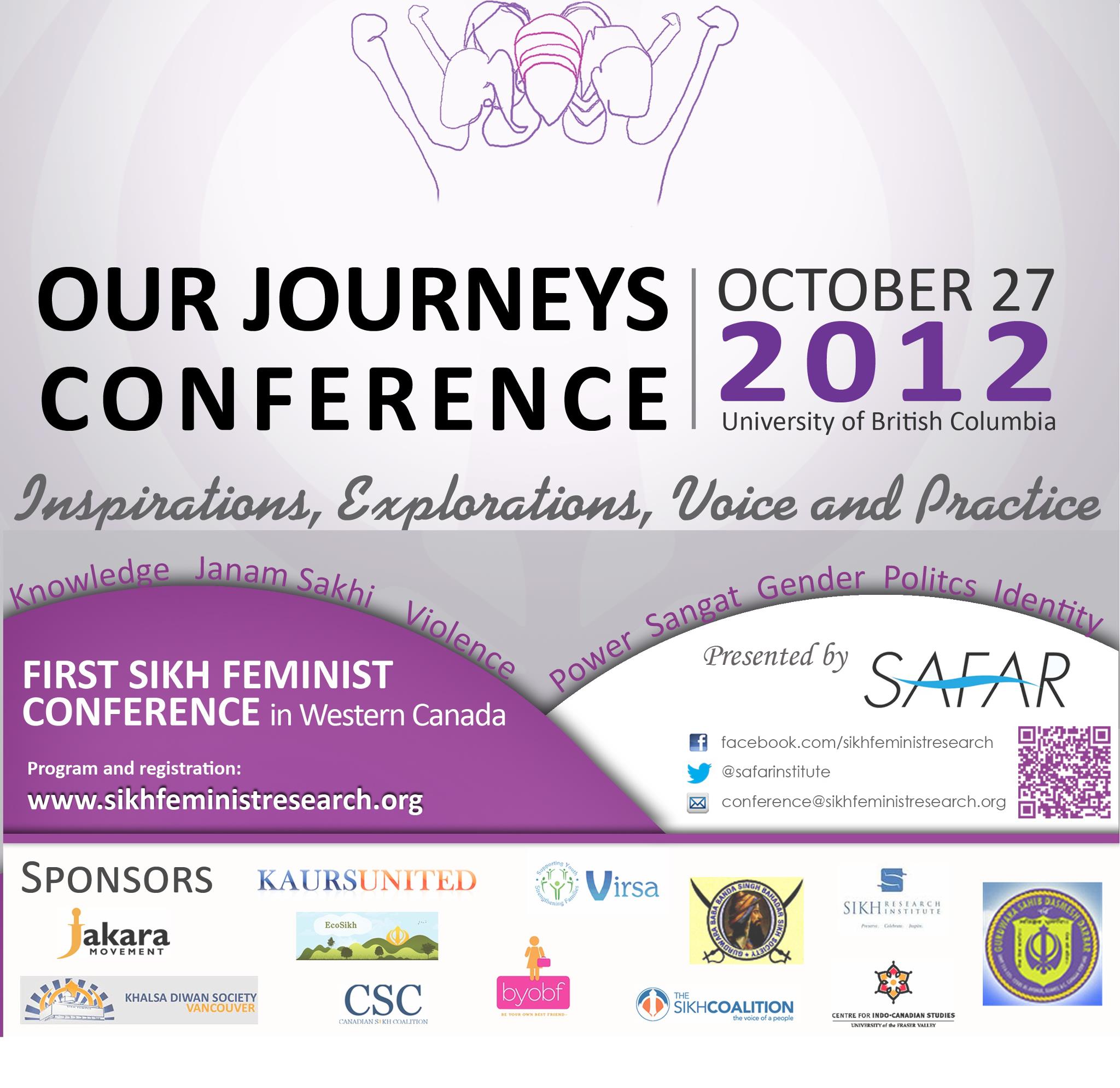 The above description is an excerpt from the “Sikh American Women and Their Love Stories Collection” presentation that will be taking place at this year’s Our Journeys conference, hosted by the Sikh Feminists Research Institute on October 27th. This conference series, the first of its kind, provides a platform to explore the intersections of Sikhi and gender. The goal is to promote research around Sikh feminist issues, heighten participation in critical discourse, promote alliance building and develop partnerships between academic and community organizations.
The above description is an excerpt from the “Sikh American Women and Their Love Stories Collection” presentation that will be taking place at this year’s Our Journeys conference, hosted by the Sikh Feminists Research Institute on October 27th. This conference series, the first of its kind, provides a platform to explore the intersections of Sikhi and gender. The goal is to promote research around Sikh feminist issues, heighten participation in critical discourse, promote alliance building and develop partnerships between academic and community organizations.
Often times, conversations about Sikhs, Sikh issues and the Sikh identity start and end with the Sikh male identity. While this conversation is acutely relevant in the climate of ignorance and discrimination that we live in, it’s also critical that we have conversations that include, are about, and are led by Sikh women.
Having attended last year’s inaugural conference, I look forward to engaging once again in a conversation around women’s issues within the Punjabi/Sikh framework. It’s exciting that we have a platform to celebrate the growth and development of the Sikh feminist voice.
This weekend, from Friday to Sunday October 19-21st, the Sikh Studies department at Hofstra University will host ‘Sikhi(sm), Literature and Film,’ a conference on literary and visual cultures in the Sikh tradition, both in Panjab and the Diaspora.
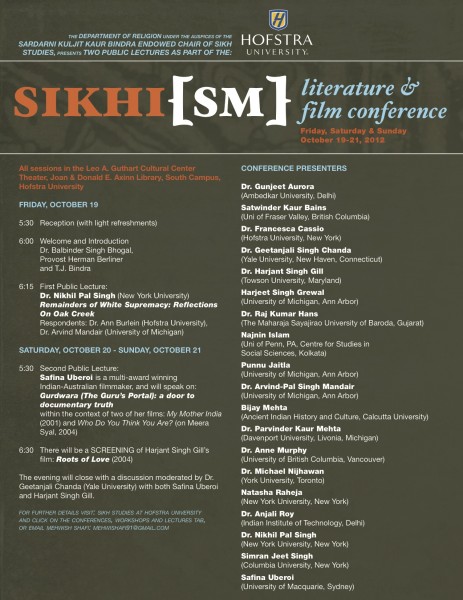 Paper presentations will be given during five sessions, with presentations ranging from de-categorizing the janamsakhis to the poetry of Puran Singh, discourses on secularism to literary representations of Sikhs, Sikh masculine identity vis-à-vis kesh and the dastaar to Panjabi theater, Museum exhibitions to Sikh identity in film and Bollywood, Hip Hop and rap as expressive forms among Panjabi youth to Gurbani sangeet and female kirtaniya. Presentation topics and bios can be accessed via the Sikh Studies website at Hofstra.
Paper presentations will be given during five sessions, with presentations ranging from de-categorizing the janamsakhis to the poetry of Puran Singh, discourses on secularism to literary representations of Sikhs, Sikh masculine identity vis-à-vis kesh and the dastaar to Panjabi theater, Museum exhibitions to Sikh identity in film and Bollywood, Hip Hop and rap as expressive forms among Panjabi youth to Gurbani sangeet and female kirtaniya. Presentation topics and bios can be accessed via the Sikh Studies website at Hofstra.
This year the conference will also host two supplementary film screenings and offer a forum to deepen the discourse around the recent Oak Creek Massacre. The films include Safina Uberoi’s ‘Gurdwara: the Guru’s Portal: a door to document Truth’ and Harjant Gill’s ‘Roots of Love,’ while the pieces related to Oak Creek include Dr. Nikhil Pal Singh’s ‘Remainders of White Supremacy,’ and Dr. Balbinder Singh Bhogal’s ‘Oak Creek Killings: The Denial of a culture of oppression’ (which can be read online).
Guest blogged by Parvinder Mehta
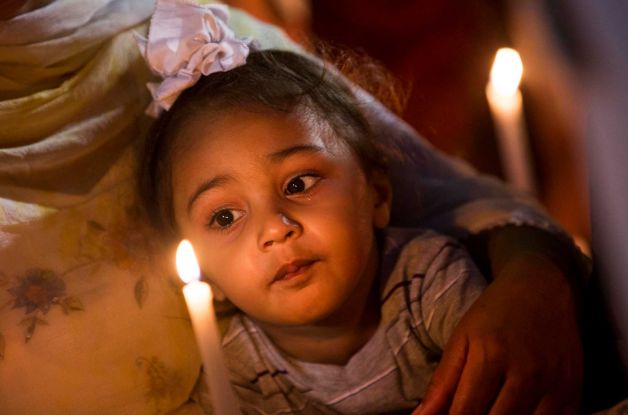 Amidst the barrage and frenzy of shock and surprise and the discussions about why the Sikh community has been targeted and victimized through history, I wonder how Sikh parents have tried to make sense of the massacre of six Sikhs and the suicide of the gunman who came with his hateful agenda to the Gurdwara in Wisconsin earlier this month. “How can one human kill another human being on purpose?” I am always haunted by this question. As a parent, I shudder at the thought of violence creeping up in our lives. It is tough explaining to your children why some people commit heinous crimes against innocent people and why some people do not like Sikhs or may have never known about Sikhs. Or explaining why a Michigan Gurdwara was vandalized last year and how ignorance can be a dangerous premise.
Amidst the barrage and frenzy of shock and surprise and the discussions about why the Sikh community has been targeted and victimized through history, I wonder how Sikh parents have tried to make sense of the massacre of six Sikhs and the suicide of the gunman who came with his hateful agenda to the Gurdwara in Wisconsin earlier this month. “How can one human kill another human being on purpose?” I am always haunted by this question. As a parent, I shudder at the thought of violence creeping up in our lives. It is tough explaining to your children why some people commit heinous crimes against innocent people and why some people do not like Sikhs or may have never known about Sikhs. Or explaining why a Michigan Gurdwara was vandalized last year and how ignorance can be a dangerous premise.
I knew I must tackle the endless questions that they would ask about why someone committed this heinous act. I knew I must not use any rhetoric of hate or fear when talking to my children, the same way as my parents had taught me. Terms like prejudice, bias, racism, and ignorance are part of my children’s vocabulary much sooner than I had hoped. As a teacher and a parent, as a proud and practicing Sikh, I have always shared the anecdotes from Sikh history with my children where courage, not fear, is the driving lesson. The crucial question that we, as Sikh American parents, are faced is how we reassure our children that such hate-driven incidents will never recur. What can we do as Sikh parents to promise our children a hate-free environment so they can assert their Sikh identities without fear?
We believe at the heart of each Sikh American woman, there are multiple love stories that inhabit the mind, body, and soul.
This one is for you dear Kaurs!
The first ever Sikh Women’s Love Anthology is being created and your voices are needed. This groundbreaking anthology will be a compilation of love stories written by and about Sikh women living in North America and will be published in the form of memoirs, creative non-fiction stories, and creative essays.
Sikh women have an incredible history of powerful and inspiring narratives – often heard through our oral tradition. This project is a way of documenting these narratives and providing a space for women in the Sikh community, connecting with one another to dialogue and document the complexities and nuanced experiences of love as we see it. Love can take many forms – “through lovers holding hands, singing a shabad, eating a good meal to nourish one’s body, hiking an unknown terrain, traveling a new country, holding a sick child close, fighting for civil and human rights or even embarking on the journey to falling in love with ourselves as women and human beings, spiritual beings” [from guidelines]. Love is at the core of our very existence as Sikhs.
This is a wonderful opportunity to pave the path for Kaur voices that we do not often hear. Sikh women who are dedicated to their families, their faith and their activism and manifest their love in dynamic ways. Yet their stories go unheard. Documenting one’s story provides for self-reflection and is “an act of resistance against social, cultural, media, and political forces that want to define women as less than humane“. This is an important way to chronicle narratives for future generations of Sikh American women and men.
Click below the break for submission details. For further information and full submission guidelines, please email sikh.lovestories[at]gmail.com.
Guest blogged by Amardeep Singh
Recently I found myself in the odd position of being, for a brief moment, a sort of spokesperson for the Sikh-American community in the wake of the terrible shootings at a Sikh Gurdwara in Wisconsin.

Page from the book, The Boy with Long Hair
It’s odd for me because I am a pretty secular Sikh, who doesn’t have an especially deep knowledge of Sikh history or theology. After my essay on “Being Sikh in America” appeared in the New York Times, a colleague at the university where I teach later invited me to give a talk on Sikhism for students at the university this fall, but I had to decline — I think others could probably do a better job. I also started saying no to interview requests and reprint requests once I felt that my main point — that we should be clear that we are “united against hate” had left its mark. And that’s just fine: while we are all still processing the horror of what happened in Oak Creek two weeks ago, it has been inspiring to see many positive and constructive voices from the Sikh community appearing in the American media.
The part that remains pressing for me as a parent is the issue I mentioned at the end of the post I wrote two weeks ago — how to talk to my children about either the immediate issue of racial and religious hostility, or even the broader question of how to educate them about Sikhism as a religion.
As I was raised, much of the heavy lifting with regards to religious education was done via Gurdwara Sunday school (in Silver Spring, MD), and various day camps for Sikh children. I don’t recall either of my parents actually sitting me down and saying, “ok, here is the story of Guru Nanak…” or anything along those lines. And as my own son becomes old enough to enroll in Sunday school at our own local Gurdwara, it’s tempting to simply continue that pattern to avoid certain uncomfortable questions (such as: “did that really happen, or is it make-believe?”). What is taught is often heavy on use of Janam Sakhis and a pretty narrow version of the accomplishments and doings of the various Gurus. And memorizing various numbers, names, and prayers: 10 Gurus, 5 Ks, Jap Ji Sahib. (No one succeeded, at that point, in teaching me much actual spoken Punjabi, so the memorization of Jap Ji Sahib was purely by rote — to impress the family back in India, maybe? I had very little idea of the meaning or context of anything I learned at Sunday school until I sought out that knowledge as an adult.)
Why isn’t that approach enough for me as a parent? Two reasons.
Guest blogged by Naujawani Sardar
 Sikhs in the UK celebrated a victory of sorts today with the news that the national broadcaster, the BBC, ‘regretted’ comments made by a presenter on their digital radio station, the BBC Asian Network. On 13 March, DJ Nihal Arthanayake had suggested on his daily call-in show that Sikhi was “made up from other religions i.e. Islam and Hinduism” [see related article]. When corrected by a listener who texted in to challenge the presenter’s comments, Nihal showed shocking arrogance in asserting that he himself was correct and replied that he knew “more about your religion than you do”. But today’s news is only a victory of sorts with Lord Inderjit Singh of the Network of Sikh Organisations describing it as “not a very good sorry” and in this writer’s humble opinion, a mere bone to keep us from tackling the real problem.
Sikhs in the UK celebrated a victory of sorts today with the news that the national broadcaster, the BBC, ‘regretted’ comments made by a presenter on their digital radio station, the BBC Asian Network. On 13 March, DJ Nihal Arthanayake had suggested on his daily call-in show that Sikhi was “made up from other religions i.e. Islam and Hinduism” [see related article]. When corrected by a listener who texted in to challenge the presenter’s comments, Nihal showed shocking arrogance in asserting that he himself was correct and replied that he knew “more about your religion than you do”. But today’s news is only a victory of sorts with Lord Inderjit Singh of the Network of Sikh Organisations describing it as “not a very good sorry” and in this writer’s humble opinion, a mere bone to keep us from tackling the real problem.
The daily call-in show on the BBC Asian Network has been steadily gaining in notoriety over the last 18 months fuelled largely by an increasing move towards discussions that court controversy. From 1pm-3pm, Monday to Friday, listeners tune in to hear the presenter, callers and occasionally guests debate a topical issue that is usually relating to a section of the South Asian community, followed by a sparse selection of music and further, more light-hearted discussion. Sometimes the initial debates have been incredibly engaging and informative, on other occasions they are needlessly provocative and disparaging.
In recent months, I have been called upon as a contributor to the show a handful of times, speaking live on air as a Sikh voice and I have publicly commended the production team of the show on two separate occasions for talking about challenging issues that are otherwise ignored by mainstream media. Following a discussion show about the recent Immortal Productions release ‘Jaago’ , a show to which I contributed by a pre-arranged telephone call, I took to Twitter to voice how fair I thought the production team had been in allowing Sikhs such as myself to make our voices heard about the rife corruption, inequality and poverty prevalent in the Indian State of Punjab over the last sixty years. Having been in Sikh political circles for over two decades now, I was unsurprised by the immediate level of hate I received from fellow Sikhs for being seen to ‘support’ Nihal and the BBC Asian Network on that occasion, but it did make me realise that Nihal in particular seemed to be drawing much of the ire. Whilst this is to some extent deserved, it would be foolish to reason that replacing the presenter might provide scope to change direction. But this is a difficult reality to impart upon a very unforgiving Sikh diaspora. I made the mistake of trying to explain to a young Sikh female on Facebook that a presenter of a call-in show usually acts in accordance with the briefing given to them by the production team, who in-turn are loosely guided by the direction given to them from the station controller or management, and that if she did have any complaints here they ought best be directed towards the BBC as well as the individual. She proceeded to reply that I must be a blind fan of Nihal’s and was planning on giving him a siropa. Oh the joys of ‘debating’ on social media(!)
The last few weeks, Sikhs around the world have been celebrating the anniversary of the birth of the Khalsa. I intended to do a Vaisakhi post earlier, but travels have kept me from sitting down and writing down some of my reflections until now. I have found myself in small and medium-sized towns throughout the midwestern and southern United States these last two weeks, feeling my outward identity as a Sikh projecting more conspicuously than ever.
NYC's Annual Sikh Day Parade
Consequently, I began thinking a lot about the significance of the Bana that Guru Gobind Singh gave us in 1699. What a fearless, defiant act of revolutionary love it was for Sikhs to wear their identity so visibly in a time when they faced such severe violent repression. A time when it was dangerous to be a Sikh, where being a Sikh meant you were an enemy of the empire, a threat, where there was a price on your head, a target on your back. Yet rather than blending into Indian society and building its movement for sovereignty and justice subversively, the Khalsa wore its identity loudly and proudly so everyone knew very clearly who a Sikh was.
I think about this today as more and more of cut our hair because we can’t take the torment of bullying in schools any more or trim our beards so we look more “professional” at our corporate jobs. Bana seems to have lost its appeal to many, for an ever-expanding list of reasons. Looking back at our history, it never has been easy. And perhaps that is part of the point. I wouldn’t wish the traumatic experience of racist harassment on anyone, but I know very well that I wouldn’t be the person I am today without all the struggles I have dealt with because of my Sikh identity.
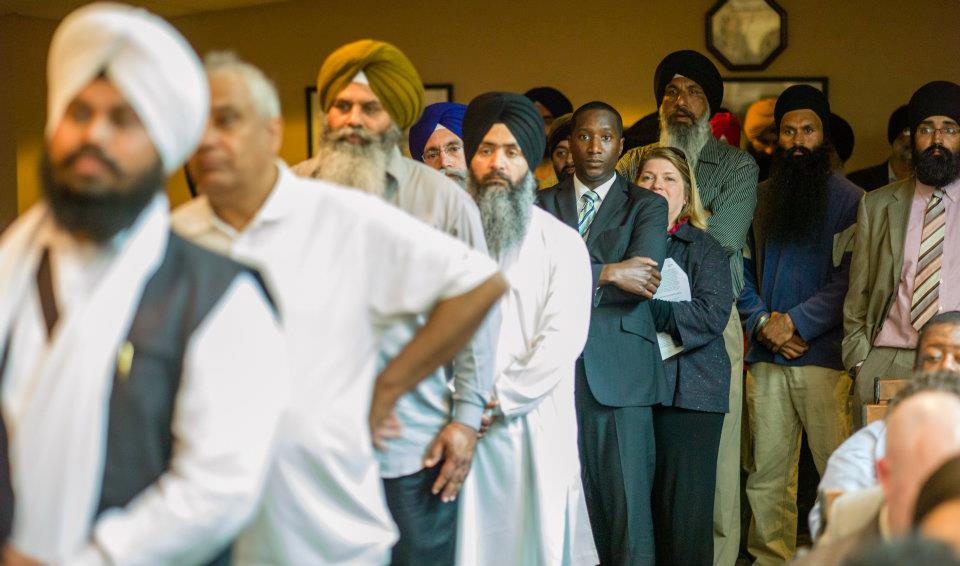
Credit: Karaminder Ghuman, Courtesy: The Sikh Coalition
The Sikh community is leading the way to strengthen law that will protect Sikhs and other religious minorities from job discrimination in the workplace. AB1964 – or the Workplace Religious Freedom Act (WRFA) – has been introduced by Assemblymember Mariko Yamada and is co-sponsored by The Sikh Coalition. Earlier this week, in a show of community leadership, the California Sikh sangat packed a hearing room in the California Assembly and testified in favor of AB1964. As a result, the bill passed through the Labor and Employment Committee and will be considered by the Judiciary Committee on Tuesday April 24th. The Sikh Coalition states that,
This is the first time in California’s history that the Workplace Religious Freedom Act has survived a committee vote, and this is a credit to the power of Sikhs to provide leadership on civil rights issues for all Americans. [link]
Why should Sikhs care about WRFA?
Sikhs suffer high levels of employment discrimination because of their Sikh identity. Many are told to shave their beards; others are told to remove their turbans; some are told that they can only work out of public view. If enacted, WRFA would make it harder in each of these cases for California employers to discriminate against Sikhs.
Guest blogged by Sharandeep Singh
Sidak, run by Sikh Research Institiute, is a diamond among jewels. It is one program, which after attending, completely changes your outlook on Sikhi, and life – I speak unequivocally when I say there is nothing else like it!
As a graduate of Sidak 2011, I want to share my experience to motivate and inspire whoever reads this to attend, so that you too can join the ranks of people who have enriched and developed their understanding of Sikh culture and history.
The annual retreat, based in Texas may seem daunting, particularly for me—it being my first trip to the US—I arrived with a feeling of trepidation, not fully aware what awaited me in the two weeks ahead. Suffice to say, I was not disappointed.

